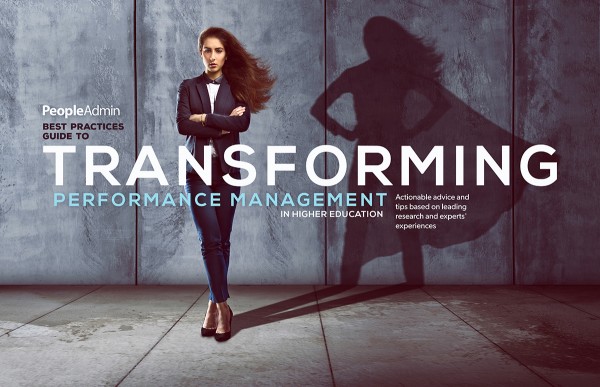
ISSUE 15
Beyond reporting: Empowering equality
‘This is an important topic when we think about not only the legal compliance and risk avoidance, but also our society in general’
Colleges and universities strive to achieve balanced hiring practices, but from a legal standpoint, many fall short without realizing it. To help institutions recognize and overcome this challenge, the PeopleAdmin research team studied the laws surrounding this complex issue and worked with developers to help you solve it.
“From an equal employment opportunity standpoint, the terminology you will generally hear is ‘adverse impact’ or ‘disparate impact.’ They mean the same thing,” explained PeopleAdmin Chief Research Officer Nick Montgomery. “It essentially means you’re not hiring legally protected groups at the rate which your applicant pool would suggest you should be.”
Determining whether your institution’s hiring practices display adverse impact comes down to a simple mathematical formula known as the four-fifths rule or the 80/20 rule.
The Uniform Guidelines on Employee Selection Procedures breaks the formula down to four steps:
- “Calculate the rate of selection for each group (divide the number of persons selected from a group by the number of applicants from that group).”
- “Observe which group has the highest selection rate.”
- “Calculate the impact ratios, by comparing the selection rate for each group with that of the highest group (divide the selection rate for a group by the selection rate for the highest group).”
- “Observe whether the selection rate for a group is substantially less (i.e., usually less than 4/5ths or 80%) than the selection rate for the highest group. If it is, adverse impact is indicated in most circumstances.”
“Let’s say you had 80 applicants who were White and 40 applicants who were Black or African-American, and you hired 48 from the White group and 12 from the Black group. That means you had a 60 percent selection rate among the White group and a 30 percent selection rate among the Black group,” Nick said. “To see whether this displays adverse impact, we simply take the 30 percent, divide it by the 60 percent, and we find that there is a 50 percent difference between those two numbers. Since that is less than federal guideline of 80 percent there is a potential for adverse impact.”
While a ratio less than 80 does indicate a meaningful difference, having a lower ratio doesn’t automatically mean an institution is in violation of the law.

“The guidelines, the legal literature, all these things say you can’t rely 100 percent on the number,” Nick said. “You must have a selection component that is related to job requirements. As long as you can prove that your hiring practices are based on candidates’ proven abilities to perform a job — and not based on their protected status(es) — that’s okay.”
Nick went on to explain that even if a large portion of your applicant pool chooses not to disclose demographic data, you should still check for adverse impact.
“You would still work with the group that has disclosed. You can get a lot of insight from that group,” Nick said. “If you know the makeup of your disclosed population, the statistical assumption would be that your undisclosed population is similar. That’s the way surveying a sample generally works.”
By properly understanding and searching for adverse impact, colleges and universities can develop more balanced hiring practices that benefit everyone.
“This is an important topic when we think about not only the legal compliance and risk avoidance, but also our society in general,” Nick said.
Disclaimer:The information contained in this story is provided as a service to the community, does not constitute legal advice, and should not be construed as legal advice or legal opinion on any specific facts or circumstances. We try to provide quality information that is current and topical, but we make no claims, promises or guarantees about the accuracy, completeness, or adequacy of the information contained in or linked to this story and its associated sites. As legal advice must be tailored to the specific circumstances of each case, and laws are constantly changing, nothing provided herein should be used as a substitute for the advice of competent counsel. Each legal problem depends on its individual facts, and different jurisdictions have different laws and regulations.
Additional resources:
- Uniform Guidelines on Employee Selection Procedures
- Department of Labor internet applicant compliance FAQ
- Technical Advisory Committee on adverse impact analyses
Balanced hiring reporting in PeopleAdmin Hire
To assist customers interested in monitoring their compliance with the law, a new Balanced Hiring Analytics dashboard will be available in PeopleAdmin Hire later this month. Features include:
- Targeted adverse impact calculation.
- Powerful analysis of potential hiring bias.
- Easy-to-use filters and criteria.
- Mobile-friendly interface.
- Alignment with EEOC guidelines on employee selection.
“We wanted to make sure that information is right at your fingertips,” said Katy Smith, product leader at PeopleAdmin. “You can very quickly see the data that is contributing to the balanced hiring ratio, the average and entire population, as well as a blue or red status indicating whether you are within the balanced hiring ratio or whether there is something that you might need to investigate further.”
Stay tuned for an email announcing the release of the adverse impact dashboard in the coming weeks.
https://peopleadmin.com/wp-content/uploads/2018/02/shutterstock_508666732.jpghttps://www.peopleadmin.com/wp-content/uploads/2018/04/kimberly-300×300.jpgShare your story
Kimberly O. McManus, Ed.D., named PeopleAdmin Inspired2Educate award winner
During PeopleConnect, PeopleAdmin’s annual user conference, CEO Jack Blaha announced 2018’s first Inspired2Educate winner: Kimberly O. McManus, Ed.D., director of disability services at Trinity Washington University, in recognition of how her kindergarten experiences with racism motivated her to ensure equitable education for K-12 and higher education students.
“Since finishing undergrad, I have taught on the K-12 level and the 2-year and 4-year college levels. I currently teach at a local two-year college in Maryland,” Kimberly said. “Each time I step in the classroom, I am sure to make everyone feel comfortable because I want all of my students — regardless of their race, their native language, their religion, their background, their sexuality — to feel that they are welcomed in my class to learn. I want them to all know that I care about them because we are all in this race together.”
Inspired2Educate is a national recognition program that encourages current and aspiring K-20 educators to honor the teachers or administrators who inspired them to embrace education as their life’s work. Each quarter, PeopleAdmin awards one person with $1,000 for professional development and $1,000 for their educational institution.
Read Kimberly’s complete submission and share your story at PeopleAdmin.com/Inspired2Educate/.
Performance management challenges. Solved.
Emily Wilson, assistant director of learning and organizational development at Appalachian State University (App State), is no stranger to performance management challenges.
“We have three different types of employees at our university — faculty, staff who are subject to the Human Resources Act and staff who are not subject to the HR Act,” Emily said. “Trying to find something that works for all of those different groups and puts everyone on the same page has been our challenge.”
While App State has not yet fully achieved that ambitious goal, three years of progress has taught Emily what it takes to overcome roadblocks.
Define your purpose
Before designing or reinventing your performance management process, Emily recommends clearly defining exactly what you want to accomplish.
“What’s your goal for doing this in the first place?” she asked. “And it can’t just be because you have to, or because HR said so — that doesn’t work.”
When defining your process, it’s important to include key stakeholders from other departments. Their involvement can help refine your purpose and increase engagement.
“One of the keys to achieving this step is getting buy-in,” Emily explained. “You have to sell it to leadership and then also to your employees and the supervisors who will be doing the reviews.”
Gaining that buy-in comes down to two things. The first is promoting the benefits of change.
“Get them to think about how it can actually be beneficial and how it can improve their quality of work,” Emily said. “We really did see it as an opportunity to do that and helped other departments see where it could provide advantages for them, as well.”
The second step is forming relationships.
“That’s part of selling. You have to have those relationships to sell something to someone. They have to trust you,” Emily said. “We talked with managers about the goals they’re thinking about setting for their employees, we talked with them about how that feeds into the mission of what they’re doing in their department, and then they realized, ‘Oh, they actually care about what we’re doing. They’re actually interested in what we’re trying to achieve.’ That’s been a huge factor in our success.”
Evaluate existing processes
“Look at your existing processes and see where they are not effective,” Emily said. “See where you can redesign a process so it can be adaptive — and so it can be based on feedback.”
The features and functionality available in Performance — PeopleAdmin’s performance management solution — help Emily to achieve this goal.
“So much of this process is about getting data,” she said. “We’re starting to build out some of our performance management data, we’re looking into it and we’re using the reporting feature. We’re always looking for ways to use that more effectively.”
Encourage continuous feedback
According to Emily, “performance management is about feedback. It’s not about ‘I have to do this.’ It’s not about pay. It’s about giving the feedback your employees need and want.”
By providing one-on-one support for employees throughout the year, performance management becomes an avenue for true departmental and institutional success.
“You’re all on the same page, everybody’s talking, everybody knows what everybody is supposed to be doing and there’s no confusion about it,” Emily said. “That feedback is what’s helping your department reach its mission, and it’s what’s helping employees grow.”
Providing continuous feedback also prevents year-end performance reviews from becoming a source of frustration.

“If you receive ongoing feedback, then your review becomes a non-issue,” Emily said. “If you’re having the kinds of conversations you need to have, when you get to the end of the year and you’re doing your review there should be no surprises. It shouldn’t be hard.”
Emily touts Performance’s progress notes feature — which makes it easier for supervisors and employees to share documented performance progress messages — for promoting those year-round conversations.
“The meat of the performance review should be what happens in the middle of the year as documented in those progress notes — which I love,” she said. “I’m a big fan.”
Help managers see the big picture
Colleges and universities can only realize performance management’s value when supervisors understand and embrace its ability to improve employee performance long term.
“I feel happy that we house performance management in learning and organizational development,” Emily said. “I can use it to support my work in that area.”
Emily helps supervisors understand how they can use performance management to identify areas where an employee can improve and determine which professional development activities would be most impactful.
“We’re not just using performance management to document,” she said. “We’re saying, ‘You struggled in this area. Let’s find you some professional development,’ or ‘This is a great coaching opportunity.’”
Embrace the process
“Culture change takes time,” Emily explained. “You can’t expect to solve every issue overnight.”
The key to maximizing progress, she said, is simplicity.
“Be patient and try to keep this as uncomplicated as possible.”

Download “Best Practices Guide to Transforming Performance Management in Higher Education” to get more tips from Emily and four other higher education talent management experts.
Download eBook
SOLUTIONS CORNER
PeopleAdmin now offers an Ethos-based integration with Colleague and Banner
PeopleAdmin Hire users can now take advantage of a seamless integration with the Ellucian Ethos Platform. The integration allows automatic updates to flow between Ellucian’s Colleague and Banner systems and PeopleAdmin’s system, eliminating duplicate data entry, dramatically reducing data inaccuracy and eradicating inconsistencies across both systems. Read the press release to learn more.
Did you miss it? Attract passive job candidates with interest cards.

To help you keep prospective candidates engaged throughout the candidate life cycle, PeopleAdmin has released an enhancement to your Hire solution.
These passive candidate engagement tools — also known as interest cards — send candidates targeted, automated communications based on their self-selected interests. The tools can now be enabled in the Admin portal.
This enhancement is free of charge and requires no setup by PeopleAdmin support.
Check out the FAQs to learn more about enabling and getting the most from this new enhancement, and watch the replay our New & Next webinar to see highlights of all our recent solution enhancements.
UPCOMING EVENTS
SUBSCRIBE
Sign up for PeopleAdmin’s newsletters to stay on top of the ever-changing world of education.
Thank you for subscribing.